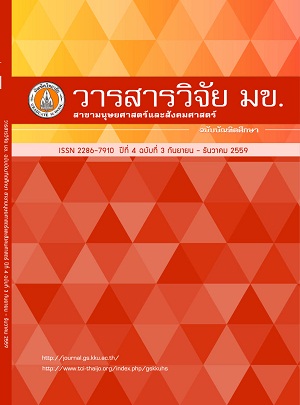การพัฒนากิจกรรมการเรียนรู้คณิตศาสตร์ตามรูปแบบการสอนวัฏจักรการเรียนรู้ 7 ขั้น ที่เน้นทักษะการคิดขั้นสูง เรื่อง สมการและการแก้สมการ ชั้นประถมศึกษาปีที่ 6
Abstract
การวิจัยครั้งนี้มีวัตถุประสงค์เพื่อ 1) พัฒนากิจกรรมการเรียนรู้คณิตศาสตร์ ตามรูปแบบการสอนวัฏจักรการเรียนรู้ 7 ขั้น 2) พัฒนาผลสัมฤทธิ์ทางการเรียนคณิตศาสตร์ ให้นักเรียนมีผลสัมฤทธิ์ทางการเรียนเฉลี่ยตั้งแต่ร้อยละ 70 ขึ้นไป 3) ศึกษาทักษะการคิดขั้นสูงของนักเรียน กลุ่มเป้าหมายที่ใช้ในการวิจัยเป็นนักเรียนชั้นประถมศึกษาปีที่ 6 โรงเรียนบ้านสะพานยาว จำนวน 26 คน การวิจัยในครั้งนี้ใช้รูปแบบวิจัยเชิงปฏิบัติการ มีวงจรปฏิบัติ 3 วงจร เครื่องมือที่ใช้ในการวิจัย แบ่งออกเป็น 3 ประเภท ดังนี้ 1) เครื่องมือที่ใช้ในการทดลองปฏิบัติ 2) เครื่องมือที่ใช้ในการสะท้อนผลการปฏิบัติ 3) เครื่องมือที่ใช้ในการประเมินประสิทธิภาพการจัดการเรียนรู้ และสรุปเป็นความเรียง ผลการวิจัยพบว่าพัฒนากิจกรรมการเรียนรู้คณิตศาสตร์ ตามรูปแบบการสอนวัฏจักรการเรียนรู้ 7 ขั้น ขั้นที่ 1 ตรวจสอบความรู้เดิม ขั้นที่ 2 สร้างความสนใจ ขั้นที่ 3 ขั้นสำรวจและค้นหา ขั้นที่ 4 ขั้นอธิบายและลงข้อสรุป ขั้นที่ 5 ขั้นขยายความรู้ ขั้นที่ 6 ขั้นประเมินผล ขั้นที่ 7 ขั้นนำความรู้ไปใช้ นักเรียนมีผลสัมฤทธิ์ทางการเรียนเฉลี่ยคิดเป็นร้อยละ 80.08 และมีจำนวนนักเรียนที่ผ่านเกณฑ์คิดเป็นร้อยละ 85.00 เป็นไปตามเกณฑ์ที่กำหนดไว้นักเรียนที่มีความสามารถในการคิดวิเคราะห์อย่างสร้างสรรค์และมีวิจารณญาณรายกลุ่ม มีคะแนนเฉลี่ยคิดเป็นร้อยละ 89.4 และนักเรียนมีความสามารถในการแก้ปัญหาอย่างสร้างสรรค์และมีวิจารณญาณรายบุคคล มีคะแนนเฉลี่ยคิดเป็นร้อยละ 81.41
The objectives of this research were to: 1) develop Mathematics learning activities based on Learning Cycle Model (7Es) emphasizing higher order thinking on Equation and Solving Equation for Prathomsuksa 6 , 2) develop students’ Mathematics learning achievement to meet the criteria of over 70 percent, and 3) study the students’ higher order thinking skills of students. The target group consisted of twenty six Prathomsuksa 6 students from Ban Sapanyaow School. Research methodology was an action research conducted in three cycles. In this research, the tools were classified into three categories: 1) Experimental tool. 2) Tools used to reflect the research action. 3) Tools used to evaluate effectiveness of learning activities, and summarize report in descriptive manner. Research findings were as follows: Result of developing Mathematics learning activities based on Learning Cycle Model (7Es): step 1 Elicitation. Step 2 Engagements. Step3 Explore and search Step 4 Explanation and conclusion. Step 5 Elaborations. Step 6 Evaluations. And step 7 Extension. The students gained the average learning achievement scores of 80.08 percent. There were 85.00 percent of students who passed the specified criteria. The students in each group showed the average scores of creative and critical thinking ability of 89.4 percent while the individual student gained 81.41 percent. In accordance with the study results has been concluded that the students had ability in solving problem skill and were able to apply the gained knowledge creatively and critically.




